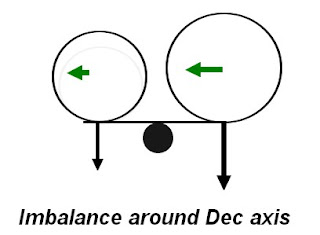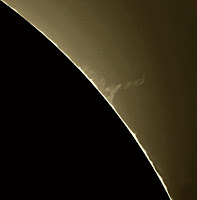*
Thursday 23rd 41F, grey overcast with fine drizzle after lunch. In the absence of the new 6" objective I have been working on the 7" refractor.
I spent the day rebuilding the long tube 7" refractor with minor modifications. I have finally painted the plywood, objective cell, adapter ring matt black. The alignment arrangement of the focuser on the tail piece of the 7" has also been improved.
The folded 7" refractor would not hold collimation if I fitted the protective caps over the folding mirrors. I just couldn't be bothered with the endless struggle to realign the optics. The OTA was very bulky when mounted and too far above head height to be useful at this time of year. When the sun is always low.
Reaching the eyepiece always needed a stepladder. As did the finder. The big mounting on its tall pier better suits the long straight tube form of refractor. Where the eyepiece can be reached from a crate even when horizontal. I really should make a sturdy, plywood box with three potential standing heights. The bulky stepladder is a complete nuisance in the dome and I am sick of carrying it up and down the steep ladder.
I'm rethinking the mounting arrangements of the new, 6" f/10, H-alpha OTA. Which will be 30cm [12"] longer and slightly larger in diameter than the present one at 160mm Ø. I can move the 7" slightly off center on the long cradle to allow the 6" to lie closely alongside. This will provide the most compact arrangement. While, hopefully, minimizing asymmetric balance problems.
The instruments on a mounting must always be balanced around both axes. Or there will a highly variable rotational force around one or both axes. I applied weights on stalks with earlier arrangements to balance the Declination rotational forces. Though this addition must be compensated for by moving the main counterbalance weights outwards. Just adding an offset finder or guide telescope can seriously throw the balance off.
It is safest to align two instruments directly inboard and outboard of each other to balance the Declination forces. Though this maximizes the need for heavier, main, counterbalance weights. It also increases the moment of the entire load. Mass x distance from the fulcrum or pivot point. In this case around the PA axis. Perhaps pushing a mounting well beyond its nominal carrying capacity. Longer instruments always have higher moment and can easily stress an inadequate mounting.

The drawing shows the effect of two instruments mounted side by side on the same saddle on crossbars. In practice the tubes are at right angles to the axis but hopefully this drawing makes it clearer.
The instruments can be imagined as heavy metal balls. For this is effectively where all the forces are concentrated in all planes. The two [very different] weights must be shifted across to balance the two around the axis. [Green arrows.]
Just like a seesaw with a heavy and light person. They must balance the system for maximum enjoyment. If they both sit as far out as each other then the heavier person will sink and stay there. The lighter person cannot move any further out than their end of the seesaw plank. So the heavier person must move inwards towards the pivot to balance the system. Now they can start moving up and down smoothly just as seesaws are intended to.
The pivot is fixed in a real seesaw but not in a pair of telescopes on [side-by-side] crossbars. The side-by-side arrangement can be shifted
as a pair across the saddle on suitable crossbars. There is obviously a limit in the minimum spacing of the pair. Spacing them further apart makes the system bulkier and increases the moment. Which should always be minimized where possible to achieve the best tracking.
In fact I can balance the telescope pair by supporting the whole system on the bench. While supported only by a thin rod to form a fulcrum under the crossbars. The thinner the rod the better. Provided it allows some free up and down movement. Too large a pivot rod will introduce other errors and the system will always want to sink and stay down at each end, in turn.
A thin rod minimizes most errors. The entire system, resting on the rod, can be rolled slowly along the bench until balance is reached. Now the crossbars can be marked for drilling to fix the pair of telescopes to the saddle. Great care must obviously be exercised not to cause damage or even drop the instruments. This is obviously far easier with smaller instruments but I have little choice in this matter.
The pair of OTAs must also be balanced at 90° in the longitudinal sense. The telescopes must be moved up and down through their rings to balance the pair around the Declination axis. Imbalance not only affects the drives but can be extremely dangerous if a shaft lock is released unwittingly. The heavy end of the system, usually the objective[s] in their cells will swing viciously downwards upon release!
When you are dealing with long and heavy instruments, like large refractors, the forces involved are considerable. If the lens cells should strike anything solid, like the pier, they may even be destroyed! The telescopes act like huge baseball bats and could do bystanders serious injury if they were struck with full force. Or, worse, trapped between the swinging telescopes and a solid surface. Like the observatory wall. Never forget to balance your telescope in all planes. Be
extremely wary of releasing axis locks or brakes unless you are absolutely CERTAIN the whole system is balanced.
Previously, I tried to use the 90mm f/11 Vixen to help the torsional balance but never really used it for viewing. The Vixen added unwanted moment. With a little care and patience the two larger refractors can be made dynamically symmetrical around the Dec axis in all planes. The difference in length between the two instruments will be made up by the PST etalon & filter stack. The considerable moment of the stack will affect the longitudinal balance. So great care must be exercised in its fitting and removal. The same holds true for heavy diagonals or solar prisms. By adding such weights to one instrument, of the pair, the other can be worked on without causing imbalance.
Contrary to my earlier belief Skywatcher do make 160mm tube rings. I have just ordered a pair from FLO.
I was planning to swap complete OTAs routinely, as needed, but have given up on that idea. Most of the time I shall be using the H-alpha 6" but don't want to lose the 7" for white light. It should make a better lunar and planetary imager too.
Friday: After inexplicable delays in transit, the 6" objective should be delivered today.
*














